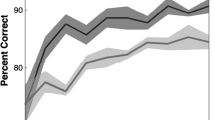Abstract
We describe an oscillatory neural network designed as a system of generalized phase oscillators with a central element. It is shown that a winner-take-all principle can be realized in this system in terms of the competition of peripheral oscillators for the synchronization with a central oscillator. Several examples illustrate how this network can be used for the simulation of various cognitive functions: consecutive selection of objects in the image, visual search, and multiple object tracking.










Similar content being viewed by others
REFERENCES
Cowan, N., Evolving conceptions of memory storage, selective attention and their mutual constraints within the human information processing system, Psychol. Bull., 1988, vol. 104, pp. 163–191.
Baddeley, A., Exploring the central executive, Q. J. Exp. Psychol., 1996, vol. 49A, pp. 5–28.
Baddeley, A., Fractionating the central executive, in Principles of Frontal Lobe Function, Stuss, D. and Knight, R.T., Eds., New York: Oxford University Press, 2002, pp. 246–260.
Kryukov, V.I., An attention model based on the principle of dominanta, in Neurocomputers and Attention I: Neurobiology, Synchronisation and Chaos, Holden, A.V. and Kryukov, V.I., Eds., Manchester and New York: Manchester Univ. Press, 1991, pp. 319–351.
Gregoriou, G.G., Gotts, S.J., Zhou, H., and Desimone, R., High-frequency, long-range coupling between prefrontal and visual cortex during attention, Science, 2009, vol. 324, pp. 1207–1210.
Kuramoto, Y., Chemical Oscillations, Waves and Turbulence, Springer Science & Business Media, 2012.
Acebron, J.A., Bonilla, L.L., Perez Vicente, C.J., and Spigler, R., The Kuramoto model: A simple paradigm for synchronization phenomena, Rev. Mod. Phys., 2005, vol. 77, pp. 37–185.
Arenas, A., Diaz-Guilera, A., Kurths, J., Moreno, Y., and Zhou, C., Synchronization in complex networks, Phys. Rep., 2008, vol. 469, pp. 93–153.
Burylko, O., Kazanovich, Y., and Borisyuk, R., Winner-take-all in a phase oscillator system with adaptation, Sci. Rep., 2018, vol. 8, article 416.
Borisyuk, R. and Kazanovich, Y., Oscillatory model of attention-guided object selection and novelty detection, Neural Networks, 2004, vol. 17, pp. 899–915.
Wolfe, J.M., Guided Search 4.0: Current progress with a model of visual search, in Integrated Models of Cognitive Systems, Gray, W., Ed., New York: Oxford, 2007, pp. 99–119.
Treisman, A.M. and Gelade, G., A feature-integration theory of attention, Cognit. Psychol., 1980, vol. 12, pp. 97–136.
Wolfe, J.M., Palmer, E.M., and Horowitz, T.S., Reaction time distributions constrain models of visual search, Vision Res., 2010, vol. 50, pp. 1304–1311.
Moran, R., Zehetleitner, M., Müller, H.J., and Usher, M., Competitive guided search: Meeting the challenge of benchmark RT distributions, J. Vision, 2013, vol. 13, no. 8, pp. 1–31.
Palmer, E.M., Horowitz, T.S., Torralba, A., and Wolfe, J.M., What are the shapes of response time distributions in visuals search?, J. Exp. Psychol. Hum. Percept. Perform., 2011, vol. 37, pp. 58–71.
Kazanovich, Y. and Borisyuk, R., Reaction times in visual search can be explained by a simple model of neural synchronization, Neural Networks, 2017, vol. 87, pp. 1–7.
Pylyshyn, Z.W. and Storm, R.W., Tracking multiple independent targets: Evidence for a parallel tracking mechanism, Spatial Vision, 1988, vol. 3, pp. 179–197.
Pylyshyn, Z.W., Visual indexes, preconceptual objects, and situated vision, Cognition, 2001, vol. 80, pp. 127–158.
Pylyshyn, Z.W. and Annan, V., Jr., Dynamics of target selection in multiple object tracking (MOT), Spatial Vision, 2006, vol. 19, pp. 485–504.
Kazanovich, Y.B. and Borisyuk, R.M., An oscillatory neural model of multiple object tracking, Neural Comput., 2006, vol. 18, pp. 1413–1440.
Oksama, L. and Hyönä, J., Is multiple object tracking carried out automatically by an early vision mechanism independent of higher-order cognition? An individual difference approach, Visual Cognit., 2004, vol. 11, pp. 631–671.
Borisyuk, G.N., Borisyuk, R.M., Kazanovich, Y.B., and Ivanitskii, G.R. Models of neural dynamics in brain information processing—the developments of 'the decade,' Phys. Usp., 2002, vol.45, pp. 1073–1095.
Kazanovich, Y.B., Nonlinear dynamics modeling and information processing in the brain, Opt. Mem. Neural Networks, 2007, vol. 16, pp. 111–124.
Hoppensteadt, F.C. and Izhikevich, E.M., Weakly Connected Neural Networks, New York Springer-Verlag, 1997.
Singer, W. and Gray, C.M., Visual feature integration and the temporal correlation hypothesis, Ann. Rev. Neurosci., 1995, vol. 18, pp. 555–586.
Chik, D., Borisyuk, R., and Kazanovich, Y., Selective attention model with spiking elements, Neural Networks, 2009, vol. 22, pp. 890–900.
Author information
Authors and Affiliations
Corresponding author
About this article
Cite this article
Yakov Kazanovich Modeling Brain Cognitive Functions by Oscillatory Neural Networks. Opt. Mem. Neural Networks 28, 175–184 (2019). https://doi.org/10.3103/S1060992X19030044
Received:
Revised:
Accepted:
Published:
Issue Date:
DOI: https://doi.org/10.3103/S1060992X19030044




